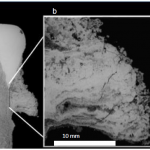Is human dental calculus a size- or shape-biased phytolith preservation context?
- Post by: Doris Barboni
- March 7, 2021
- 1 Comment
A comment by Robert Power
There has been increasing interest in dental calculus as a source of information on early diet, lifestyle, and environment. A significant portion of this research has reported phytoliths trapped in this context, although they are less commonly reported than starch granules. Dental calculus is a unique context for the preservation of phytoliths as it has a biologically constrained deposit size, unlike sediment or residues. Dental calculus deposits in humans vary enormously in size but they typically occur as a band on teeth closest to the salivary glands such as incisors. These bands are typically less than 5 mm thick but occasionally can be 20 mm or thicker. Unsurprisingly, multi-cellular phytoliths which often occur as sheets hundreds of microns long are rarely reported in dental calculus as they presumably would be removed from the surface of plaque by the tongue or a dental hygiene aid before calcification may occur. Where they occur they are often relatively small fragmented examples less than 100 microns (Jovanović et al 2021). However, research has not clarified whether dental calculus is a size-biased context, which could determine its phytolith representativeness. Research by the author has been shown it is biased in favour of the preservation of palm phytoliths (dimensions average length= 9.2, width=7.7 n=1036; Power et al. 2015), while it under preserved tracheids, common in the local diet, this may relate to palm phytolith size, their unusually resistant chemical makeup, or it may be simply that their echinates more readily stick to dental plaque. Research is needed to establish drivers of phytolith incorporation into dental plaque.

Figure 1: SEM tooth cross section. Light colouration of dental calculus indicates its dense structure, this along with relatively small volumes leaves little room in dental calculus for phytolith preservation a) SEM-EDS image of calculus on a tooth section, b) inset SEM-EDS image of layering in the dental calculus that accumulate over years. Photo credit: Robert Power, Monica Tromp.
References
Jovanović J, Power RC, de Becdelievre C, Goude G, Stefanović S. 2021. New insights into cereal use during the Mesolithic-Neolithic transition in the Danube Gorges: data from dental calculus analysis. Journal of Archaeological Science, 125, 105288.
Power RC, Salazar-García DC, Wittig RM, Freiberg M, Henry AG. 2015. Dental calculus evidence of plant diet and life history transitions in the Taï Forest Chimpanzees. Scientific Reports, 5, 15161.


I partly agree with this. I have looked at close to 100 samples now from South East Asia and Mongolia (unfortunately not yet published) where there are often greater than or eual to 100 grass-type phytoliths found within dental calculus of a single individual. This includes bilobates, buliforms, and in some cases multicellular phytoliths up to 100 microns long. I think at this stage it would be fair to say that the majority of published dental calculus studies come from populations with more heavily processed food/less phytolith rich foods rather than there being a huge bias based on phytolith size and shape. Having said that, as Robert points out, the almost velcro-like nature of palm phytoliths and the fact that they occur in almost every part of a palm tree would likely make them common and perhaps overrepresented in diets where palm was being consumed.